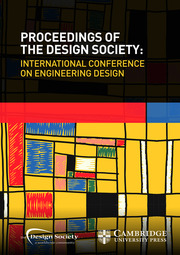No CrossRef data available.
Article contents
Hybrid Prototyping: Pure Theory or a Practical Solution to Accelerating Prototyping Tasks?
Published online by Cambridge University Press: 26 July 2019
Abstract
Physical prototyping is critical activity in the produce development process, but the cost and time required to produce prototypes hinders it use in the design process. Hybrid prototyping through coupling LEGO and FDM printing is presented as an approach to address these issues. After establishing the separate design rules for FDM printing and LEGO, this paper created new set of rules called Design for Fabrication (DfF) for hybrid prototyping. These cover the three main considerations (Technical, Process, and Design) that the designer and process planning must include to practically implement LEGO and FDM hybrid prototyping. The DfF rules were considered in a prototype of a computer mouse. While the fabrication time was not reduced as expected, it showed that the rules could be practically implemented in a real-world example. Additional considerations were identified that are to be included in the DfF rules.
Further work is required to realise the predicted step-change reduction in fabrication time. The first approach is to leverage multiple printers to parallelise the printing. The second is to reduce fidelity while maintaining high fidelity in key regions of interest.
- Type
- Article
- Information
- Proceedings of the Design Society: International Conference on Engineering Design , Volume 1 , Issue 1 , July 2019 , pp. 759 - 768
- Creative Commons
- This is an Open Access article, distributed under the terms of the Creative Commons Attribution-NonCommercial-NoDerivatives licence (http://creativecommons.org/licenses/by-nc-nd/4.0/), which permits non-commercial re-use, distribution, and reproduction in any medium, provided the original work is unaltered and is properly cited. The written permission of Cambridge University Press must be obtained for commercial re-use or in order to create a derivative work.
- Copyright
- © The Author(s) 2019


